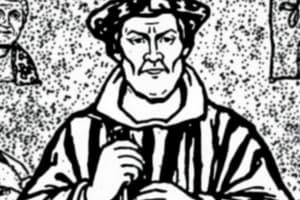Podcast
Questions and Answers
Quem é frequentemente considerado a figura principal da Reforma Protestante?
Quem é frequentemente considerado a figura principal da Reforma Protestante?
- Francisco de Assis
- Martinho Lutero (correct)
- Tomás de Aquino
- João Calvino
Qual foi o evento que marcou o início da Reforma Protestante em 1517?
Qual foi o evento que marcou o início da Reforma Protestante em 1517?
- Estabelecimento da Companhia de Jesus
- Concílio de Trento
- Morte de João Calvino
- Publicação das 95 Teses por Martinho Lutero (correct)
Qual foi o principal ponto de controvérsia entre a Igreja Católica e os reformadores protestantes?
Qual foi o principal ponto de controvérsia entre a Igreja Católica e os reformadores protestantes?
- Venda de indulgências (correct)
- Reforma dos mosteiros existentes
- Estabelecimento de novas ordens religiosas
- Concílio de Trento
Quais foram algumas das ordens religiosas estabelecidas durante a Contrarreforma?
Quais foram algumas das ordens religiosas estabelecidas durante a Contrarreforma?
Qual foi a estratégia utilizada pelos líderes da Contrarreforma contra a heresia?
Qual foi a estratégia utilizada pelos líderes da Contrarreforma contra a heresia?
O que era a Contrarreforma da Igreja Católica?
O que era a Contrarreforma da Igreja Católica?
Qual foi o principal objetivo do Concílio de Trento?
Qual foi o principal objetivo do Concílio de Trento?
Quem foi o principal líder responsável por iniciar a Reforma Protestante no século XVI?
Quem foi o principal líder responsável por iniciar a Reforma Protestante no século XVI?
Qual doutrina foi negada pelo Concílio de Trento, indo contra as ideias propostas por Martinho Lutero?
Qual doutrina foi negada pelo Concílio de Trento, indo contra as ideias propostas por Martinho Lutero?
Qual foi um dos resultados importantes do Concílio de Trento em relação aos sacramentos da Igreja Católica?
Qual foi um dos resultados importantes do Concílio de Trento em relação aos sacramentos da Igreja Católica?
O que foi enfatizado pelo Concílio de Trento em relação à autoridade na Igreja Católica?
O que foi enfatizado pelo Concílio de Trento em relação à autoridade na Igreja Católica?
Qual crença foi confirmada pelo Concílio de Trento em relação ao purgatório?
Qual crença foi confirmada pelo Concílio de Trento em relação ao purgatório?
Flashcards are hidden until you start studying
Study Notes
Protestant Reformation and Counter-Reformation
The Protestant Reformation was a pivotal period in European history, marked by a movement to reform the Catholic Church and establish new religious institutions. This movement, initiated by Martin Luther and others in the early 16th century, challenged the authority of the Catholic Church and led to the establishment of various Protestant denominations. In response, the Catholic Church launched its own campaign of reform, known as the Counter-Reformation or Catholic Reformation.
Council of Trent
The Council of Trent, held from 1545 to 1563, was a significant event in the Counter-Reformation. Convened by Pope Paul III, the council aimed to address the issues raised by the Protestant Reformation and reaffirm the teachings of the Catholic Church. Some of the key outcomes of the Council of Trent include:
- Denial of the Lutheran idea of justification by faith alone, reaffirming the Doctrine of Merit which allows for salvation through good works and the sacraments.
- Affirmation of the existence of purgatory and the usefulness of prayers and indulgences in shortening a person's stay in purgatory.
- Reaffirmation of the belief in transubstantiation and the importance of all seven sacraments.
- Reaffirmation of the authority of both scripture and the teachings of the Church.
- Reaffirmation of the necessity and correctness of religious art, as long as it is used to honor the holy figures depicted and to set before the eyes of the faithful examples of the saints.
Martin Luther
Martin Luther, a German theologian, is often regarded as the main figure of the Protestant Reformation. In 1517, he began the Reformation by nailing his Ninety-five Theses to the door of a church in Wittenberg, Germany. These theses criticized the selling of indulgences and questioned the authority of the Catholic Church. Despite being excommunicated by the Church, Luther's ideas spread rapidly, inspiring similar movements in other parts of Europe.
Indulgences
The sale of indulgences was a practice in which the Catholic Church granted permission for the remission of sins or a reduction in the time spent in purgatory after death. This practice generated significant controversy and was a major point of contention between the Catholic Church and the Protestant reformers, who argued that salvation could not be bought or sold.
Catholic Counter-Reformation
The Counter-Reformation was the Catholic Church's response to the Protestant Reformation. It aimed to reform the Church from within, curb abuses, and reaffirm traditional Catholic teachings. The Counter-Reformation was marked by the establishment of new religious orders, such as the Jesuits, Theatines, and Capuchins, as well as the reformation of existing orders, like the Carmelites. The popes of the Counter-Reformation were men of sincere conviction and initiative who skillfully employed diplomacy, persuasion, and force against heresy.
In conclusion, the Protestant Reformation and Counter-Reformation were two major movements in European history that shaped the religious landscape of the continent. The Protestant Reformation, led by figures like Martin Luther, aimed to reform the Catholic Church and establish new religious institutions, while the Counter-Reformation, marked by the Council of Trent, was the Catholic Church's response to these challenges. Both movements had a profound impact on the religious, social, and political landscape of Europe.
Studying That Suits You
Use AI to generate personalized quizzes and flashcards to suit your learning preferences.




